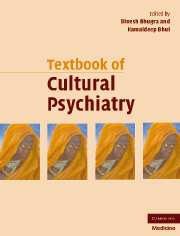Book contents
- Frontmatter
- Contents
- Contributors
- Foreword
- Preface
- Part I Theoretical background
- Part II Culture and mental health
- Part III Culture and mental disorders
- Part IV Theoretical aspects of management
- 26 Traumascape: an ecological–cultural–historical model for extreme stress
- 27 Sexual dysfunction across cultures
- 28 Therapist–patient interactions and expectations
- 29 Developing mental-health services for multicultural societies
- 30 Psychopharmacology across cultures
- 31 Psychotherapy across cultures
- 32 Psychological interventions and assessments
- 33 Spiritual aspects of management
- 34 Cultural aspects of suicide
- Part V Management with special groups
- Part VI Cultural research and training
- Cultural psychiatry: the past and the future
- Index
- References
26 - Traumascape: an ecological–cultural–historical model for extreme stress
from Part IV - Theoretical aspects of management
Published online by Cambridge University Press: 11 August 2009
- Frontmatter
- Contents
- Contributors
- Foreword
- Preface
- Part I Theoretical background
- Part II Culture and mental health
- Part III Culture and mental disorders
- Part IV Theoretical aspects of management
- 26 Traumascape: an ecological–cultural–historical model for extreme stress
- 27 Sexual dysfunction across cultures
- 28 Therapist–patient interactions and expectations
- 29 Developing mental-health services for multicultural societies
- 30 Psychopharmacology across cultures
- 31 Psychotherapy across cultures
- 32 Psychological interventions and assessments
- 33 Spiritual aspects of management
- 34 Cultural aspects of suicide
- Part V Management with special groups
- Part VI Cultural research and training
- Cultural psychiatry: the past and the future
- Index
- References
Summary
EDITORS' INTRODUCTION
The relationship between social factors and mental well-being of individuals is well described. The individual responses to social stressors in the environment can influence outcome and the coping strategies. In addition, the social factors such as geographical distance may prevent individuals and their carers from seeking help. It is possible that the shape of distress changes as the social conditions change and mould individual's distress. The relationships between environment and the individuals are most starkly seen in post-disaster situations, whether the disasters are man-made or natural. Coping strategies in disaster settings include basic survival needs along with psychological trauma.
De Jong in this chapter builds on the concept of traumascape, described as a landscape marked by the need for people to build memorials at sites where massive deaths have happened. The characteristics of these traumascapes are the systemic dynamics of local and international representations and actions around extreme stress. In post-disaster situations, irrespective of the causation, the stakeholders have divergent perceptions, which produce interventions, which are not necessarily related to needs and concerns of the local communities or scientific evidence-based proven professional interventions. De Jong develops an ecological–cultural–historical model for extreme stress in which person is presented as part of a hierarchy of levels of organization. Historically, collective and individual dimensions can be understood. Ecologically, corresponding historical, economic and political processes are identified. There is no doubt that historical factors influence culture. The relationship between the individual on the one hand and ecological factors on the other is significantly influenced by role expectations.
- Type
- Chapter
- Information
- Textbook of Cultural Psychiatry , pp. 347 - 363Publisher: Cambridge University PressPrint publication year: 2007
References
- 12
- Cited by



